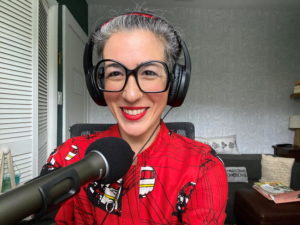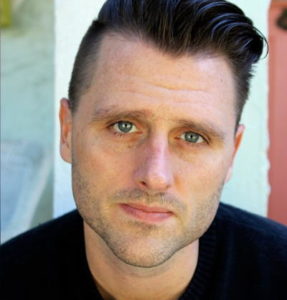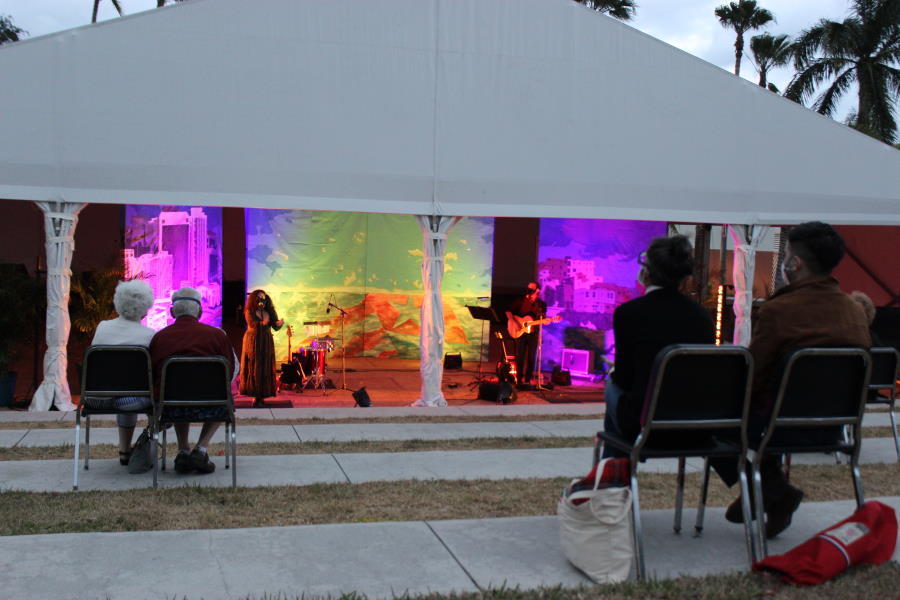In this conversation between playwright Vanessa Garcia and Matt Stabile, artistic director of Theatre Lab at Florida Atlantic University (FAU), they talk about the making of their new hybrid audio play, Ich Bin Ein Berliner, in which Vanessa retraces and unravels her relationship to pop culture, capitalism, Berlin, and her own family’s history as it relates to our present moment. Think of it a bit like this: What the Constitution Means to Me meets an illustrated cartoon, set in the 1980s and ’90s, and wearing 501 Blues with rivets.
The piece was created specifically for streaming (through May 23) as an enhanced audio play with a visual companion, including animated illustrations by John Shamburger and video production by Nick Chimienti. It was also Theatre Lab’s first in-person event in over a year, launching their 2021 season with a socially distanced but fully communal listening experience. The play happened to premiere on the playwright’s birthday, April 3, and the group Hola Hi created original music alongside the piece, which resonated with the words: “We are not free until we are all free…Ich Bin Ein Berliner.”
VANESSA GARCIA: Okay, Matt. So how did this whole thing start? As I remember it, over a year and a half ago, maybe more, I wrote you an email about how I was obsessed with the Berlin Wall, ever since I saw it fall from my fifth grade classroom (on TV). That moment shook me to my core. The question was: Why? I wanted to answer that in a play, and I envisioned the audience inside my fifth grade classroom with me, at desks, etc. You replied: Tell me more! That’s so exciting for a playwright, because usually, at least for me, these ideas get ignored when they’re fledglings. I usually have to really show people everything—whole. What made you say, tell me more?
MATT STABILE: I mean, the idea of working on something from scratch with you was the real thing that made me say “tell me more.” We’d worked together on a couple of your projects, one of mine, but those typically ended at the workshopping point. That needed to change. Running a theatre dedicated to new work, I never want to be the person saying why an idea won’t work from the start. Bring the ideas. Let’s talk about them, dream about them, and see what we can make.
I was also really excited by the idea of the audience taking on the role of the students. I love trying to subvert what an audience views as their “traditional” role. At that point, I had no idea how that would work, considering that our space isn’t really a “flex” space. But I am typically drawn to projects that start with: “Well, I don’t know if we can pull that off, but…”
GARCIA: I think that’s why we work so well together. It’s like, “Wow, how in the world will we make this?!” That thought excites us both, I think.
Eventually, what ended up happening was, um: 2020. Yeah…Covid-19. Anti-bacterial everything. Trump. George Floyd. BLM. The world falling apart around us. Or maybe just breaking so that we could put it back together another way. That’s kind of what happened with this play too, right? Because instead of an immersive experience, which would have been impossible, you reached out to commission me to write an audio play.
STABILE: Late in the summer of 2020, when we realized this “intermission” was going to go on for a while, we were trying to figure out ways to get folks working again. We had a choice: Do we commission new plays on Zoom? Or do we look to the past to create something new, something that will, hopefully, continue to be viable after the pandemic ends? We went with the latter, and I’m glad we did. We plan to continue to produce work like this even after we are able to return to in-person performance.
As for why specifically audio: I love audio plays. I spent about two years working with a company down here directing radio versions of classic films from the ’40s and ’50s. I loved the way the format forced you to think differently about how to communicate story. Back when I was teaching, I used to do this lesson about the difference between live theatre and film. I’d put two chairs on the stage and say, if you’re making a movie about a car chase, you’d better have a packed street with actual cars slamming through carts full of apples. If you’re doing a play, suddenly these two chairs are enough. Because the thing you gain in theatre is the audience is willing to lend you their imagination in a way they aren’t always willing to do in film. When you go to audio, you’re taking that one step further. The audience has become the scenic designer, costume designer, lighting designer—it’s all in their mind. And I really love that.

GARCIA: Considering what you’re saying, that the audience is such a big part of art and theatre, and if, then, both the theatremaker and audiences filter the material that’s presented, then what the heck is “universality”? Or “specificity,” for that matter? What’s wrapped up in those terms? I know it’s something I ask myself all the time. How important they are, how they help, but also how they hinder and hurt.
STABILE: Oh, man. This is a bit of a loaded question. You and I have spoken at length about this and I am going to start with the old paradigm: The more specific you make the details of the story to your experience, the more universal the story actually becomes. I think your play does this incredibly well. It takes the more widely “American” memory of the fall of the Berlin Wall and uses it to explore your very unique experience as a Cuban American. And within that, this universal experience of longing and the desperation of forced separation is released.
GARCIA: You said, “I’m going to start,” like there’s a lot more to it. I agree—I think we get bogged down by the trap of universality to a certain degree, because it’s complicated. And maybe there’s no such thing?
STABILE: I think there’s been this strange obsession with some of the—how do I put this—establishment of the American theatre industry to want to question whether or not your very unique experience will connect to a broader audience. And I just find this so bizarre. Ultimately, we are talking about a human experience; that’s what theatre does, right? Reveals the intricacies of the human experience. And I just find it strange that there’s been this question of, “Well, but will a ‘traditional’ audience connect to/care about this?” Nobody seems to ask that of a story about a traveling salesman living out his memories and final days in Brooklyn, which I’d argue is a very specific experience. The idea that someone can decide what is or isn’t “universal” based on whether or not it more closely matches their own life experience—you know, I think that’s exposing a major issue in theatrical criticism too.
GARCIA: Right. No one, not any person on earth, has the same experience. And yet we can connect to almost anyone when we really listen to their story. The question is, will we actually give people the chance to tell their own stories all the way through? Which is the only way to really get others to hear them, because the only people who know the thing fully (truthfully) are the people who know the details no one else could imagine. So important.

STABILE:That’s really important—if not the most important. Who gets to choose which stories get told, who gets to tell those stories, who gets to participate in the telling of those stories, who gets to decide what the potential “value” of those stories? I remember an actor breaking down in tears after the first read of Ich Bin Ein Berliner, just overwhelmed that a story she connected to on such a deep level, a generational level, was being invested in and shared. I think that brought a level of authenticity to the work that, frankly, I don’t think can be underestimated.
We were careful to cast the show with Cuban American and Latinx actors. We brought in a guest director to work on the show. At first, I was primarily in a supporting role. I was not expecting to direct the fully produced version. We have a standing policy at the Lab to begin with the playwright, to ask them what they need (including the makeup of the artistic team) to bring their vision to life. You kind of surprised me when you asked me to direct the full version.
GARCIA: For me, I felt like you got this story, because we’re the same age, both kids from South Florida and the magic city of Miami, and the things inside us, what we filtered—it’s all part of a shared experience. Our prisms are different, like everybody’s, but we root from the same ground.
STABILE: Ultimately, the way forward for me was to make sure that you were involved with all the major decision-making. To make sure I was always focused on telling your story in the best way possible. You were there on casting, on building the artistic team, on audio discussions, throughout most of the pre-pro on the visual component. And I think we ended up with that thing you’re always looking for in a production: a true team environment where everyone is contributing and sharing in the sincere dedication to telling the story and leaving all the other silly stuff that can come with this industry out of the room.
GARCIA: Which was all amazing, as a playwright. But you’re being humble, because what you added to this project was brilliant. The visual component had so much heart—I felt so happy and “on mission” in the room. Which is what I guess what you’re saying: We were all in it together.
And maybe the context, the fact that we were still making art in spite of, because of, and through a global pandemic had something to do with it, partly. Which brings me to the next big thought I have here, which is that we talked a lot about what we were going to do when we “came back” to the world of live performance. Do you think we’ve learned something being away? Have we really changed like we promised we would?
STABILE: Ugh. This is such a good question. I don’t know if we’ve changed. I see evidence that part of the we have. I have. Our company has. I keep saying that once you’ve seen something, you can’t unsee it. You can choose to ignore it, and that’s what worries me most right now. As I see us all start to gear back up for productions, I’m afraid that some of the lessons we learned in the “intermission” will be swept aside when the machine starts to get running at full speed again.
I think a lot of theatre companies felt pressure last summer. Pressure to issue the statement. To promise change. And the thing with pressure is that it will inevitably release. I think we’re seeing that a bit now. But momentum continues to build. Momentum leads to real movement.
No individual is going to change an industry. No one company is going to do it either. But when each individual remains vigilant about their responsibility, and companies make honest and actionable evaluations of their practices, and regions find groups banding together in support of that change, well, I think eventually the momentum will require those people who don’t think there is a problem to reexamine themselves.
You know, I think most people in theatre think they’re in the business of empathy, and so how could they possibly be doing something to hurt/disenfranchise someone? And that’s just a product of being unable to set aside your own experience and realize that almost everything you know about this business was taught to you in the form of a system that benefits you.
GARCIA: Ich Bin was the first in-person show at Theatre Lab in over a year. Now that moment has been etched in my head in a very similar way to the fall of the Berlin Wall. It’s just going to be one of those moments I remember, for lots of seasons and lots of reasons.
STABILE: I mean…it was magic. I remember very clearly hearing the audience laugh together in the first few minutes. And I sort of froze. I hadn’t heard an audience laugh together in over a year! And then they were gasping together, and tears together, and then, finally, applause. Real-life applause, not the jazz hands through Zoom stuff. And I realized that this was what was really making it a unique experience: sharing it with others. I’ll never take that part of the experience for granted again.
The audio version of Ich Bin Ein Berliner is available for $5 through May 23. Just click here. The enhanced visual companion is available for $15 (illustrated and animated), also through May 23, just click here.


